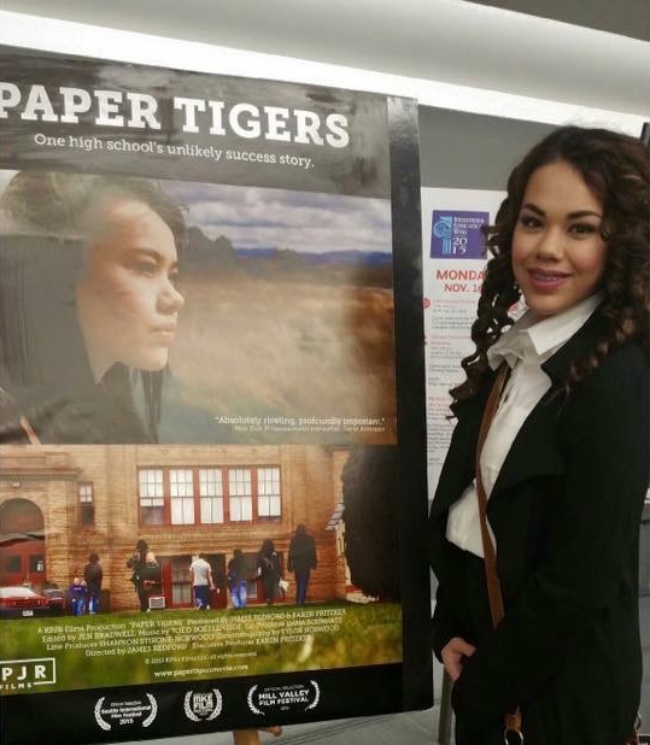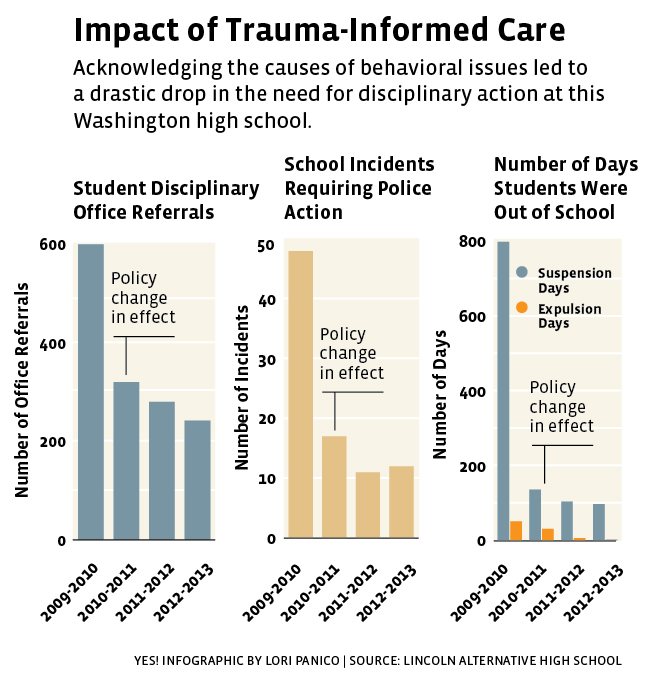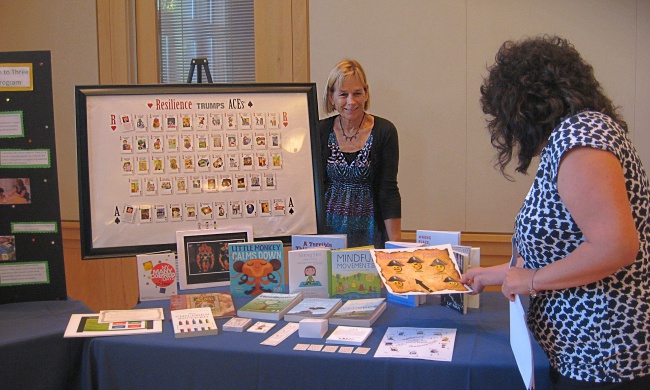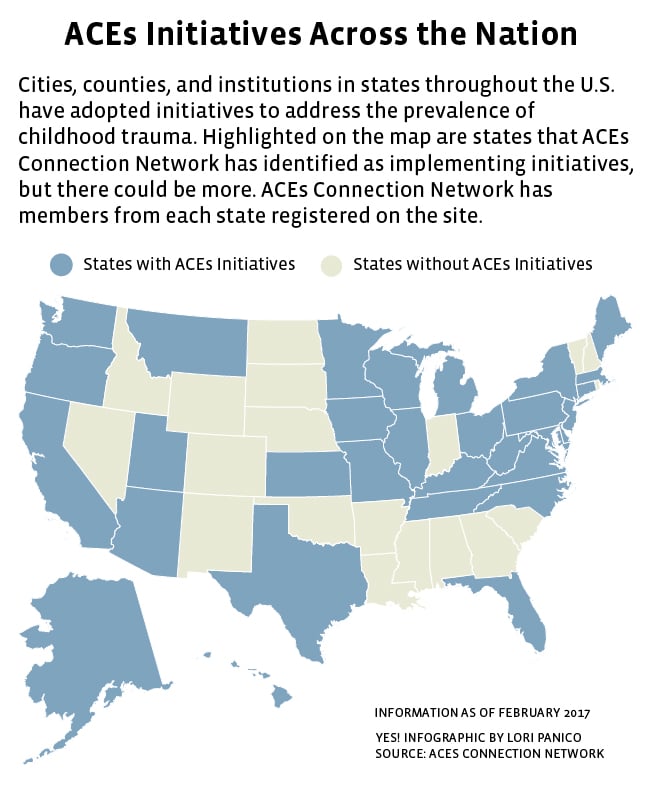This Town Adopted Trauma-Informed Care—And Saw a Decrease in Crime and Suspension Rates

Former Lincoln Alternative High School Principal Jim Sporleder and Kelsey Sisavath. Photo courtesy of Jim Sporleder.
A few months into her freshman year at Lincoln Alternative High School, Kelsey Sisavath got into a fight with a girl outside of class. She was sent to the principal’s office and arrived still fuming. There was a time at Lincoln, a school once known as a last resort for those who were expelled from the area’s other high schools, when fights often ended in out-of-school suspensions or arrests. But Principal Jim Sporleder didn’t immediately scold her. Instead, he asked how she was doing, then left her alone in the office with a granola bar, a water bottle, and some tissues to dry her tears. When he returned half an hour later, Sisavath was feeling calm enough to talk.
“If he would have asked me the details and talked about punishment right away, it probably would have just pushed me even more off of the edge,” she reflected.
At the time, her personal life was riddled with pain. For years, Sisavath had bounced back and forth between her mother, who was addicted to opiates, and her emotionally distant father. Just two years earlier, she had been sexually assaulted by a stranger. All of these experiences left her feeling emotionally and physically neglected. In the eighth grade, she started hanging out with kids in gangs and skipping class to smoke marijuana.
That kind of behavior followed her to high school, where she could have faltered. But Sisavath’s experience at Lincoln was different. Sporleder and the staff created an environment built on empathy and redemption through a framework called trauma-informed care, which acknowledges the presence of childhood trauma in addressing behavioral issues. The practices vary depending on the environment, but they begin with the understanding that childhood trauma can cause adulthood struggles like lack of focus, alcoholism, drug abuse, depression, and suicide.
Lincoln Alternative High School is in the small city of Walla Walla in southeastern Washington. It had been a place for students with disciplinary issues, those removed from the area’s other high schools, ordered there by a judge, or those who had performed poorly in middle school.
Childhood trauma can cause adulthood struggles.
Tucked in the middle of a residential neighborhood, Lincoln’s brick edifice and cherry-red doors now serve as a place of opportunity for many students. At Lincoln, the first trauma-informed high school in the nation, the graduation rate increased by about 30 percent and suspensions decreased by almost 85 percent a year after implementing the framework. The school’s success, along with the advocacy efforts of relentless community leaders, convinced service providers throughout the city to adopt trauma-informed care in their own fields.
Today, an electric utility provider, the Division of Children and Family Services, the police department, and many others have all committed to raising awareness of traumatic childhood experiences and to providing internal resources to foster a safe and healthy community. As more cities and states consider childhood trauma a public health issue, Walla Walla’s success has transcended this former trading town. It now serves as a model for resilience-building in the burgeoning trauma-informed care movement that is sweeping the nation.
The tipping point began in 1998 with a landmark study of over 17,000 patients in Southern California that showed the pervasiveness of trauma. The CDC-Kaiser Permanente Adverse Childhood Experiences Study asked participants if they had experienced any of 10 types of childhood trauma, called adverse childhood experiences, or ACEs. These include direct emotional, physical, and sexual abuse; a mother treated violently; a family member with substance dependence or mental illness; parental separation or divorce; a household member who was incarcerated; and emotional and physical neglect. The more types of trauma a person had experienced, the study found, the more predisposed they were to social, behavioral, and emotional problems and the adult onset of chronic illness. Nearly two-thirds of the participants were found to have experienced at least one traumatizing childhood event. Some specialists have since added other ACEs, such as experiencing racism or witnessing violence.
“My discipline was punitive and it was not teaching kids.”
Around the same time as the ACE study, a group of researchers and pediatricians at Harvard University and elsewhere were conducting research showing that toxic stress, the frequent or continual strain on a young child without adequate adult support, could negatively impact the child’s brain development. Out of this research came an increased interest in trauma’s impact on the brain. Educators and doctors began wondering if childhood trauma could be prevented, or if its impacts could be minimized.
On the first day of her freshman year in 2012, Sisavath noticed that her high school was different. The hallways were plastered with large posters that listed traumatic experiences like emotional abuse beside examples of how to build resilience. On one, the words “attachment to a caring adult” accompanied a colorful cartoon of an adult and child ice-skating. Sisavath started adding up her own childhood traumas as she walked past the posters and soon realized that she had experienced seven of the 10 ACEs.

Kelsey Sisavath in front of a Paper Tigers poster—a documentary she was featured in about Lincoln Alternative High School’s trauma-informed care practices. Photo by Jolene Pond.
At Lincoln, students and teachers mingled in a natural way, unlike traditional school settings, where student cliques often dominate campus. Even in cold weather, principal Sporleder stood bundled up at the school’s entrance greeting students with a high-five and a smile. “I’m happy that you’re here,” he said as students rushed past him.
But the relationship between students and staff at Lincoln wasn’t always so symbiotic. When Sporleder first arrived at the school in April 2007, he said, about five or six gangs roamed the halls and an intern with little administrative experience was running the school. The building was in a constant state of chaos. Students freely hurled profanities. So Sporleder took a hard line by handing out automatic three-day out-of-school suspensions for every “f— you.”
Then, in the spring of 2010, he attended a workshop in Spokane, Washington, on the impacts of stressful childhood experiences. Keynote speaker John Medina, a developmental molecular biologist, explained how toxic stress overfills the brain with cortisol, also known as the stress hormone. Sporleder suddenly understood that his students’ behavior wasn’t completely in their control; their brains were affected by toxic stress. “It just hit me like a bolt of lightning that my discipline was punitive and it was not teaching kids,” he said. He hunted for curriculum to bring this understanding into the classroom, but found none. So he set out on a mission to bring trauma-informed care to his students.

Most of the students he oversaw at Lincoln had experienced multiple forms of trauma, and were in poverty and on free or reduced lunches. “That’s like running the trauma hospital,” Sporleder said. “We were dealing with crisis after crisis after crisis.”
He brought a researcher into the school to train the teachers in trauma-informed care and started replacing out-of-school suspensions with in-school ones. He allowed students to ask for a break when they could sense that their traumas were being triggered. Staff members visited the homes of students who skipped class to figure out what was wrong and how they could help them return to school. The school also provided students with free on-campus counseling and basic health care through a health clinic that received initial funding from a local medical center. There, students could get birth control pills and ibuprofen.
“I don’t know what it is,” Sisavath remarked about the staff at Lincoln. “They just have such a great connection with kids and it’s unreal.”
As the situation at Lincoln improved, Walla Walla began to take notice. Soon, trauma-informed practices that spawned in the school spread throughout the rest of the city. Getting to this point, however, had not been a quick or simple effort.
Theresa Barila moved to Walla Walla in 1984. For about 20 years, she worked as a fisheries biologist in the federal salmon and steelhead recovery program of the Pacific Northwest. Her research specialty was fish stress. When her daughter was diagnosed with autism spectrum disorder, she decided to resign from her position and pick up a part-time job with an organization that offered resources and services for at-risk youth. It was there she was introduced to the study of childhood trauma and ACEs.
Two years before Lincoln became a trauma-informed school, Barila introduced ACE awareness to Walla Walla. Today, she is the director of the Children’s Resilience Initiative, a community response to childhood trauma, and she credits her scientific background studying stress as a motivation for learning how to prevent and deal with ACEs.
“Yeah, it was for fish, but systems are pretty similar,” she quipped.

Theresa Barila at a Children’s Resilience Initiative event. Photo courtesy of Theresa Barila.
At first, Walla Walla residents were skeptical. “This just feels like you’re having a pity party. Where’s the accountability?” Barila recalled community members asking. But to her, a decade of research on the effects of toxic stress on the brain held the keys to understanding behavior. She knew the city could use that information to uncover the roots of trauma in its community.
Resistance has not been specific to Walla Walla. “In 2008, a lot of people would hear about this and think, This is voodoo,” said Jane Stevens, a veteran health reporter who created a social journalism network called ACEs Connection after learning of the Kaiser study. But today, she says, it’s incontrovertible science, and now the focus is on how best to integrate that understanding.
So what changed in the American psyche in the past 20 years for trauma-informed care to gain momentum?
Stevens says her network and the work of many leaders in the movement have helped raise awareness. She likens it to the slow and steady progress of every scientific revelation. “It’s sort of like plate tectonics in geology: For hundreds of years, people thought that the continents never moved,” she said. Although scientists proposed well beforehand that plates moved, “it wasn’t until the 1950s and 1960s that plate tectonics was accepted and integrated into geology; and then in earthquake-prone zones, the science was the foundation for changes in building codes, engineering codes, urban planning, emergency response, etc.”

Nearly 10 years after introducing trauma-informed care to Walla Walla, Barila foresees a major breakthrough in resilience-building. The success of Lincoln High School and the enthusiasm of former Principal Sporleder have converted other partners in the community. The Children’s Resilience Initiative created a Memorandum of Understanding in September 2013 with more than 20 community organizations, agencies, and service providers, ranging from the Department of Corrections to a local medical center. They each agreed to create a community that understands the impacts of trauma, brain development, and ways to foster resilience. Walla Walla County Sheriff John Turner has incorporated some of those practices into law enforcement; Barila trained all of the deputies to acknowledge that toxic stress affects brain architecture.
“I think it just added another layer of understanding to some of the issues that [deputies] come across in the field, and it’s easier for them to manage their own emotions toward people that are being unruly toward them,” Turner said. Along with crisis intervention and mental health training, trauma-informed practices gave deputies a deeper understanding of human behavior. It helped them to exercise patience with people who behave disorderly and to deescalate situations.
“It might be something in the person’s physiology, anatomy, or brain structure that they can’t help,” Turner added. “It’s easier to not take it as personally, and it’s easier to deal with the actual situation, as opposed to dealing with the emotions of it.”
Within the past several years, FBI crime statistics in the county have dropped. Although Turner thinks that trauma-informed training has been valuable, he stresses that additional training and hiring decent officers also have impacted those results.
Acts of understanding, patience, and kindness have helped transform strangers into partners and friends. To Annett Bovent, a parent in Walla Walla, ACEs awareness helped illuminate the roots of her own problems and connected her to her neighbors. “People care. Before, I always felt like I was alone, and I don’t feel that way anymore,” she said. Suddenly, the town seemed to transform from black and white to color. “I feel like, to me, the information is common sense, but it was like I was the only one who heard it. And now it’s like everyone wants to know.”
Trauma-informed practices gave deputies a deeper understanding of human behavior.
Since retiring in 2014, former Lincoln Principal Sporleder has remained busy flying around the country speaking at educational and community conferences. He recently attended a workshop in Sacramento, California, where he consulted 25 principals, some of whom oversaw thousands of students. They discussed how they could use Lincoln’s model for their own schools, where some have 10 times the population of Lincoln. “I was amazed at how, once they started talking with each other, they were coming up with a model,” Sporleder recounted. An alternative school in Bend, Oregon, is among the many that has built on Lincoln’s example.
For Sisavath, trauma-informed care has had a lasting impact on her life. She graduated last spring with honors and is currently working part time at Dairy Queen while she attends a local community college. She said she doesn’t take things as personally as she once did, and has learned that behaviors often derive from childhood trauma. Her high school experience also sparked an interest in psychology and philosophy, which she hopes to pursue in college.
“There’s so many things that happen outside of the classroom that can’t be helped in school,” she explained. “If every teacher knew the techniques, knew what to do, knew how to support these kids, it would make a huge difference.”
This article was funded in part by the Surdna Foundation.

|
Melissa Hellmann
reports on artificial intelligence at The Seattle Times and is a former Surdna reporting fellow for YES!.
|






